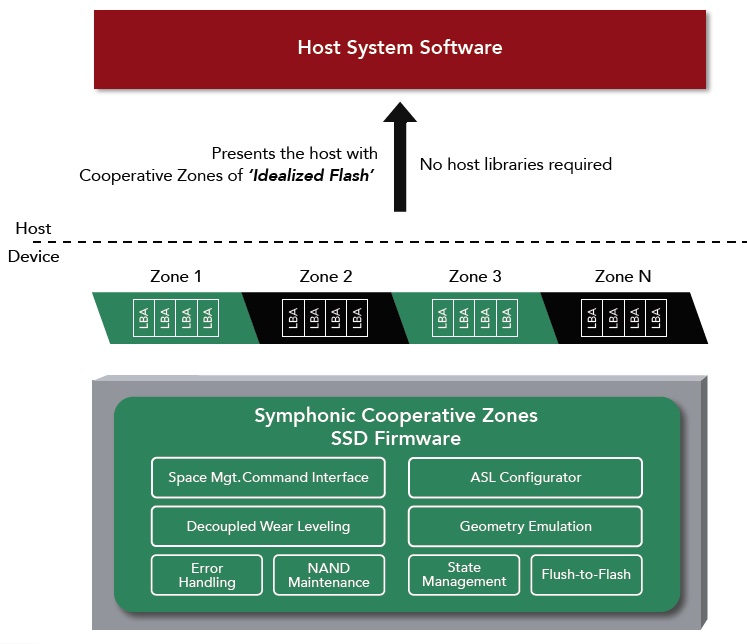Radian Memory Systems can make SSDS last longer and perform more predictably and consistently.
The company has released its branded Symphonic Cooperative Zones technology on its RMS-350 U.2 and RMS-325 edge card SSDs. This is how it works.
Radian sub-divides SSDs into zones that can be operated and managed together with the host. The outcome is a reduction in unexpected latency delays, increased parallelism – equals more performance – and endurance.
Lost in Flash Translation
Currently SSDs have a Flash Translation Layer and carry out garbage collection and wear-levelling themselves, with no reference to the host (asynchronously). These operations can interfere with and delay host-initiated read and write requests; the host sees an unexpected latency spike.
They can also cause more writes than anticipated, in a process known as write amplification. This reduces the working life, or endurance, of the SSD.
The newly-arrived QLC (4bits/cell) SSDs have intrinsically lower endurance than TLC (3bits/cell) SSDs and so write amplification is more undesirable. In turn TLC flash has lower endurance than MLC (2bits/cell) flash.
Radian sets up so-called co-operative zones that can be accessed in parallel. These consist of NAND blocks – or NAND Erase Units in Radian terminology. They are subsets of a physically separate region of the SSD, based upon NAND dies and channels, and called an iso-box.
Zones are configurable in size and the host sees sequential write zones of idealised flash, mini virtual SSDs. The co-operative zones appear as a range of contiguous logical block addresses (LBAs) accessible via conventional addressing through the NVMe command set.

Symphonic Cooperative Zones
Cooperative zones can be factory-configured to support different types of memory, ranging from NVRAM to SLC (1bit/cell) and TLC today, and for SCM (Storage-Class Memory) and QLC in the future. Radian also says the technology supports specialised ultra low latency SLC variations in the future as well. Blocks & Files understand this refers to Samsung’s Z-SSD and other possible products.
This feature can be used to tier data within an SSD to maximise performance, capacity and cost efficiencies.
Routine wear levelling and NAND maintenance (data retention, scrubbing, error handling) are performed internally by the SSD. The device initiates co-operative requests to the host if required data movement could conflict with other (host-initiated) I/O access.
If additional wear levelling or other NAND maintenance is required that could conflict with host I/O access latencies, the host is also alerted. That means the host can respond by rescheduling IO requests.
As part of garbage collection, hosts are responsible for selecting valid data and a relocation destination on a different zone, either performing a copy/write operation directly or using Radian’s optional Delegated Move command (NVMe vendor extension) that delegates the data transfer to the SSD.
Zones are erased through the use of a ‘Zone Reset’ command (NVMe vendor extension) that is issued by the host to the SSD, or via a zone aligned NVMe deallocate command.
Radian emphasises no host library support is needed. The functionality is carried out entirely by SSD device firmware.
Write amplification can also be caused by mismatches between the host file system’s segment size and the ones used by the SSD. Radian has an Address Space Layout (ASL) configurator which enables users to configure the SSD zones to match the host file system’s segment size. This eliminates the write amplification that would otherwise occur if the host segments and SSD zones were not aligned.
Further FTLs, if log-structured, can have their own internal garbage cleaning operations, and these can can conflict with regular garbage collection, causing more wrote amplification and latency spiking. Because Radian’s technology eliminates the FTL this additional write amplification and latency spiking are both eliminated.
Radian supplies its SSD technology and products to system OEMs, cloud providers, and for licensing to device manufacturers. The company says thousands of its NVMe storage devices have been deployed in data centre applications by some of the industry’s largest OEMs.








